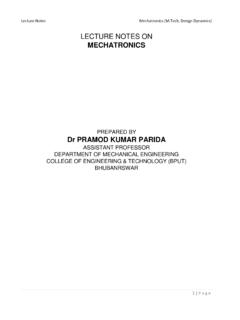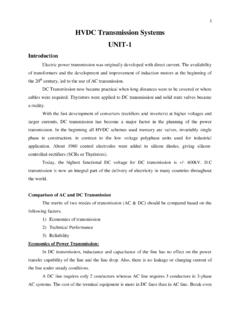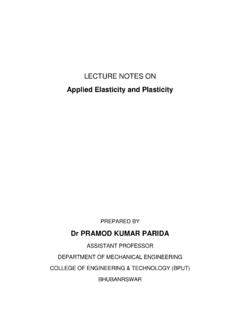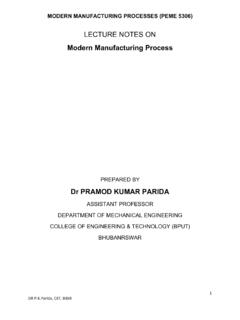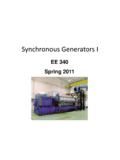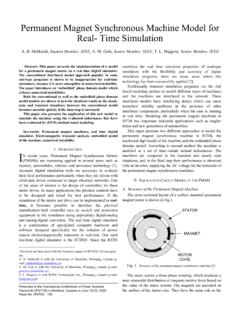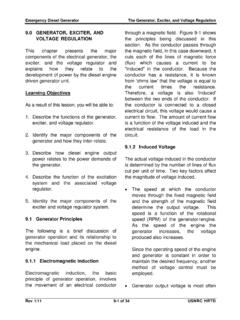Transcription of POWER SYSTEM STABILITY - College of Engineering and ...
1 POWER SYSTEM STABILITY LESSON SUMMARY-1:- 1. Introduction 2. Classification of POWER SYSTEM STABILITY 3. Dynamic Equation of synchronous machine POWER SYSTEM STABILITY involves the study of the dynamics of the POWER SYSTEM under disturbances. POWER SYSTEM STABILITY implies that its ability to return to normal or stable operation after having been subjected to some form of disturbances. From the classical point of view POWER SYSTEM instability can be seen as loss of synchronism ( , some synchronous machines going out of step) when the SYSTEM is subjected to a particular disturbance.
2 Three type of STABILITY are of concern: Steady state, transient and dynamic STABILITY . Steady-state STABILITY :- Steady-state STABILITY relates to the response of synchronous machine to a gradually increasing load. It is basically concerned with the determination of the upper limit of machine loading without losing synchronism, provided the loading is increased gradually. Dynamic STABILITY :- Dynamic STABILITY involves the response to small disturbances that occur on the SYSTEM , producing oscillations. The SYSTEM is said to be dynamically stable if theses oscillations do not acquire more than certain amplitude and die out quickly.
3 If these oscillations continuously grow in amplitude, the SYSTEM is dynamically unstable. The source of this type of instability is usually an interconnection between control systems. Transient STABILITY :- Transient STABILITY involves the response to large disturbances, which may cause rather large changes in rotor speeds, POWER angles and POWER transfers. Transient STABILITY is a fast phenomenon usually evident within a few second. POWER SYSTEM STABILITY mainly concerned with rotor STABILITY analysis. For this various assumptions needed such as: For STABILITY analysis balanced three phase SYSTEM and balanced disturbances are considered.
4 Deviations of machine frequencies from synchronous frequency are small. During short circuit in generator, dc offset and high frequency current are present. But for analysis of STABILITY , theses are neglected. Network and impedance loads are at steady state. Hence voltages, currents and powers can be computed from POWER flow equation. Dynamics of a synchronous machine :- The kinetic energy of the rotor in synchronous machine is given as: KE=1/2 Jws2 x10 -6 (1) Where J= rotor moment of inertia in kg-m2 ws = synchronous speed in mechanical radian/sec.
5 Speed in electrical radian is wse = (P/2) ws = rotor speed in electrical (2) Where P = no. of machine poles From equation (1) and (2) we get KE= (3) or KE= MJ Where M = = moment of inertia in (4) We shall define the inertia constant H, such that GH = KE = (5) Where G = three-phase MVA rating (base) of machine H = inertia constant in MJ/MVA or From equation (5), we can write, M = (6) or M = (7) M is also called the inertia constant.
6 Assuming G as base, the inertia constant in per unit is M(pu) = Sec2 (8) or M(pu) = Sec2 (9) LESSON SUMMARY-2:- 1. Swing equation 2. Multi machine SYSTEM 3. Machines swinging in unison or coherently 4. Examples Swing Equation:- GENERATORPeTmWsTePm ( Flow of POWER in a synchronous generator) Consider a synchronous generator developing an electromagnetic torque Te(and a corresponding electromagnetic POWER Pe) while operating at the synchronous speed ws. If the input torque provided by the prime mover, at the generator shaft is Ti, then under steady state conditions ( , without any disturbance).
7 Te = Ti .. (10) Here we have neglected any retarding torque due to rotational losses. Therefore we have Te ws= Ti (11) And Te ws - Ti ws = Pi - Pe = (12) When a change in load or a fault occurs, then input POWER Pi is not equal to Pe. Therefore left side of equation is not zero and an accelerating torque comes into play. If Pa is the accelerating (or decelerating) POWER , then Pi- Pe = .. (13) Where D = damping coefficient e = electrical angular position of the rotor It is more convenient to measure the angular position of the rotor with respect to a synchronously rotating frame of reference.
8 Let = e .. (14) So .. (15) Where is POWER angle of synchronous machine . eWsRotor FieldReference rotating axisReference axis ( Angular Position of rotor with respect to reference axis) Neglecting damping ( , D = 0) and substituting equation (15) in equation (13) we get (16) Using equation (6) and (16), we get (17) Dividing throughout by G, the MVA rating of the machine , (18) Where .. (19) or (20) Equation (20) is called Swing Equation.
9 It describes the rotor dynamics for a synchronous machine . Damping must be considered in dynamic STABILITY study. Multi machine SYSTEM :- In a multi machine SYSTEM a common base must be selected. Let Gmachine = machine rating (base) Gsystem = SYSTEM base Equation (20) can be written as: .. (21) So pu on SYSTEM (22) Where ..(23) = machine inertia constant in SYSTEM base Machines Swinging in Unison (Coherently) :- Let us consider the swing equations of two machines on a common SYSTEM base.
10 (24) .. (25) Since the machines rotor swing in unison, 1 = 2 = ..(26) Adding equations (24) and (25) and substituting equation (26), we get .. (27) Where Pi = Pi1 + Pi2 Pe = Pe1 + Pe2 Heq = H1 + H2 Equivalent inertia Heq can be expressed as: .. (28) Example1:- A 60 Hz, 4 pole turbo-generator rated 100 MVA, KV has inertia constant of 10 MJ/MVA.

